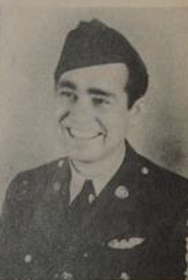Technical Sergeant Morris Junior Gecowets
Morris Junior Gecowets was a Mark Center boy, born March 12, 1918, to Henry and Audrey (Stuckman) Gecowets. A 1939 graduate of Mark Center High School, he went on to Defiance College where he earned a Bachelor of Arts. On August 28, 1940, his number #2418 was called in the draft drawing.

He entered the U.S. Army on November 13, 1941, training at Scott Field, Illinois; Harlington, Texas and in Utah. He was training to be a gunner in the bombers that would raid Europe in the war. Off he went to the European Theater in August 1942.

In April 1943, his parents learned that Morris was reported as Missing in Action after a raid over Europe near Bremen, Germany.
On the front page of the Crescent-News on April 24, 1943:
"MORRIS GECOWETS MISSING IN ACTION
Mark Center, April 24 - Morris J. Gecowets, 25, a bomber gunner, has been missing in action in the European area since April 17, according to word received today by his parents, Mr. and Mrs. Henry Gecowets, from the war department.
Technical Sergeant Gecowets had been in service since Nov. 13, 1941, and had been overseas since last August. He is believed to have been located in England.
Recently he was awarded an air medal for service in action.
He was born March 12, 1918, was graduated from Mark Center high school and in 1939 from Defiance College with a bachelor of arts degree.
Max Gecowets, star basketball player at Ohio State University, who is now an air cadet stationed at Memphis State College, Memphis, Tenn. and Lee Gecowets, at home, are brothers."
www.americanairmuseum.com Morris was part of this crew as the waist gunner.
The museum gave this description of the incident where Morris was wounded, and eventually died of his wounds:
"On 17 April, 1943, was the leading aircraft of the 36th low squadron on a mission to Bremen (Germany) in a B-17 41-24488 'Banshee II" Fighters attacked the plane. Left with one engine, they headed back toward land. Another fighter raked the plane and killed five crewmen in the back of the plane. The remainder of the crew bailed out in the Frisian Islands and were captured to become Prisoners of War."
The plane crashed into a dyke (ditch) near Greetsiel, Germany, after enemy fire took out three engines.
On June 3, 1943, Morris Gecowets was officially declared dead.
The Crescent-News reported his fate:
"SGT GECOWETS LISTED AS DEAD. RED CROSS CONFIRMS LOSS OF MARK CENTER MAN IN BOMBER.
Mark Center, June 3 - Death of Technical Sergeant Morris J. Gecowets, 25, son of Mr. and Mrs. Henry Gecowets of Mark Center, in the European area of April 17, was announced today in a telegram received by the parents from the adjutant general's office in Washington.
The telegram stated that a report received from the German government, through the International Red Cross had confirmed death of Sergeant Gecowets, who previously had been listed as missing in action since April.
No details of how the Mark Center soldier met his death were contained in the telegram, which said a letter would follow. He was a bomber gunner and had been in overseas service since August, 1942.... He had received the air service medal for service in action...."
Morris also received the Purple Heart posthumously.
Morris was brought home and buried in the Six Corners Cemetery, Hicksville Township, Defiance County.
Mary Williams, Researcher













































_at_Suva,_Fiji_Islands,_on_23_June_1942_(NH_89418).jpg)

